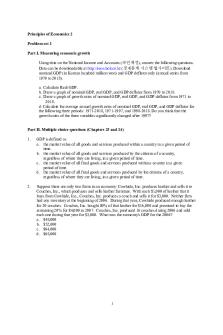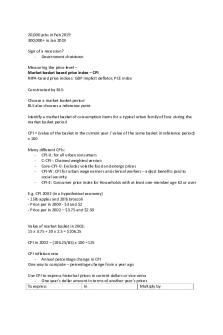GDP and CPI PDF

Summary
Download GDP and CPI PDF
Description
Principles of Economics 2 Problem set 1 Part I. Measuring economic growth Using data on the National Income and Accounts (국민계정), answer the following questions. Data can be downloadable at http://ecos.bok.or.kr (경제통계 시스템 웹사이트). Download nominal GDP (in Korean hundred million won) and GDP deflator only (annual series from 1970 to 2018). a. Calculate Real GDP. b. Draw a graph of nominal GDP, real GDP, and GDP deflator from 1970 to 2018. c. Draw a graph of growth rates of nominal GDP, real GDP, and GDP deflator from 1971 to 2018. d. Calculate the average annual growth rates of nominal GDP, real GDP, and GDP deflator for the following three periods: 1971-2018, 1971-1997, and 1998-2018. Do you think that the growth rates of the three variables significantly changed after 1997? Part II. Multiple choice questions (Chapters 23 and 24) 1.
GDP is defined as a. the market value of all goods and services produced within a country in a given period of time. b. the market value of all goods and services produced by the citizens of a country, regardless of where they are living, in a given period of time. c. the market value of all final goods and services produced within a country in a given period of time. d. the market value of all final goods and services produced by the citizens of a country, regardless of where they are living, in a given period of time.
2.
Suppose there are only two firms in an economy: Cowhide, Inc. produces leather and sells it to Couches, Inc., which produces and sells leather furniture. With each $1,000 of leather that it buys from Cowhide, Inc., Couches, Inc. produces a couch and sells it for $3,000. Neither firm had any inventory at the beginning of 2006. During that year, Cowhide produced enough leather for 20 couches. Couches, Inc. bought 80% of that leather for $16,000 and promised to buy the remaining 20% for $4,000 in 2007. Couches, Inc. produced 16 couches during 2006 and sold each one during that year for $3,000. What was the economy's GDP for the 2006? a. $48,000 b. $52,000 c. $64,000 d. $68,000
1
3.
Transactions involving items produced in the past, such as the sale of a 5-year-old automobile by a used car dealership or the purchase of an antique rocking chair by a person at a yard sale, are a. included in current GDP because GDP measures the value of all goods and services sold in the current year. b. included in current GDP but valued at their original prices. c. not included in current GDP because GDP only measures the value of goods and services produced in the current year. d. not included in current GDP because these items have no current value.
4.
Which of the following is included in the investment component of GDP? a. households’ purchases of newly constructed homes b. net additions to firms’ inventories c. firms’ purchases of capital equipment d. All of the above are correct.
5. Which of the following items is the one type of household expenditure that is categorized as investment rather than consumption? a. spending on education b. the purchase of stocks and bonds c. the purchase of a new house d. the purchase of durable goods such as stoves and washing machines 6.
A good is produced by a firm in 2007, added to the firm’s inventory in 2007, and sold to a household in 2008. It follows that a. the value of the good is added to the investment category of 2007 GDP, added to the consumption category of 2008 GDP, and subtracted from the investment category of 2008 GDP. b. the value of the good is added to the investment category of 2007 GDP, added to the consumption category of 2008 GDP, and not included in the investment category of 2008 GDP. c. the value of the good is added to the investment category of 2007 GDP, subtracted from the consumption category of 2008 GDP, and not included in the investment category of 2008 GDP. d. the value of the good is added to the investment category of 2007 GDP, subtracted from the consumption category of 2008 GDP, and added to the investment category of 2008 GDP.
7.
When an American household purchases a bottle of Italian wine for $100, a. U.S. consumption does not change, U.S. net exports decrease by $100, and U.S. GDP decreases by $100. b. U.S. consumption does not change, U.S. net exports increase by $100, and U.S. GDP increases by $100. c. U.S. consumption increases by $100, U.S. net exports decrease by $100, and U.S. GDP does not change. d. U.S. consumption increases by $100, U.S. net exports do not change, and U.S. GDP increases by $100.
8.
In the economy of Wrexington in 2008, real GDP was $5 trillion and the GDP deflator was 200. What was Wrexington’s nominal GDP in 2008? a. $2.5 trillion b. $10 trillion c. $40 trillion d. $100 trillion
2
Table 1. The table below contains data for the country of Dachsland, which produces only pretzels and books. The base year is 2005. Year
2005 2006 2007 2008 9.
Price Quantity Price Quantity of of of of Pretzels Pretzels Books Books $4.00 90 $1.50 150 $4.00 100 $2.00 180 $5.00 120 $2.50 200 $6.00 150 $3.50 200
Refer to Table 1. Dachsland’s output grew a. 29.9% from 2005 to 2006. b. 33.3% from 2006 to 2007. c. 24.3% from 2006 to 2007. d. 15.4% from 2007 to 2008.
10. Which of the following is not a correct statement about the growth of real GDP in the U.S. economy? a. Real GDP in 2004 was almost four times its 1965 level. b. Growth was steady between 1965 and 2004. c. Continued growth in real GDP enables the typical American to enjoy greater economic prosperity than his or her parents and grandparents did. d. The output of goods and services produced grew on average about 3.2 percent per year between 1965 and 2004. 11. The CPI is more commonly used as a gauge of inflation than the GDP deflator is because a. the CPI is easier to measure. b. the CPI is calculated more often than the GDP deflator is. c. the CPI better reflects the goods and services bought by consumers. d. the GDP deflator cannot be used to gauge inflation. 12. When computing the cost of the basket of goods and services purchased by a typical consumer, which of the following changes from year to year? a. the quantities of the goods and services purchased b. the prices of the goods and services c. the goods and services making up the basket d. All of the above are correct. 13. In an imaginary economy, consumers buy only hot dogs and hamburgers. The fixed basket consists of 10 hot dogs and 6 hamburgers. A hot dog cost $3 in 2006 and $5.40 in 2007. A hamburger cost $5 in 2006 and $6 in 2007. Which of the following statements is correct? a. When 2006 is chosen as the base year, the consumer price index is 90 in 2007. b. When 2006 is chosen as the base year, the inflation rate is 150 percent in 2007. c. When 2007 is chosen as the base year, the consumer price index is 100 in 2006. d. When 2007 is chosen as the base year, the inflation rate is 50 percent in 2007. 14. Which of the following is not a widely acknowledged problem with using the CPI as a measure of the cost of living? a. substitution bias b. introduction of new goods c. unmeasured quality change d. unmeasured price change
3
15. The substitution bias in the consumer price index refers to the a. substitution by consumers toward new goods and away from old goods. b. substitution by consumers toward a smaller number of high-quality goods and away from a larger number of low-quality goods. c. substitution by consumers toward goods that have become relatively less expensive and away from goods that have become relatively more expensive. d. substitution of new prices for old prices in the CPI basket of goods and services from one year to the next. 16. The consumer price index and the GDP deflator are two alternative measures of the overall price level. Which of the following statements about the two measures is correct? a. The two measures are constructed differently, but they always indicate the same inflation rate. b. The substitution bias applies equally to both measures. c. A change in the price of Korean televisions is reflected in the U.S. consumer price index but not in the U.S. GDP deflator. d. All of the above are correct. 17. Babe Ruth's 1931 salary was $80,000. Government statistics show a consumer price index of 15.2 for 1931 and 207 for 2007. Ruth's 1931 salary was equivalent to a 2007 salary of about a. $5,874. b. $1,089,474. c. $1,216,000. d. $16,560,000. 18. Ethel purchased a bag of groceries in 1970 for $8. She purchased the same bag of groceries in 2006 for $25. If the price index was 38.8 in 1970 and the price index was 180 in 2006, then what is the price of the 1970 bag of groceries in 2006 dollars? a. $5.39 b. $25.00 c. $29.11 d. $37.11 19. Ralph puts money in the bank and earns a 5 percent nominal interest rate. If the inflation rate is 2 percent, then after one year, a. Ralph will have 3 percent more money, which will purchase 5 percent more goods. b. Ralph will have 3 percent more money, which will purchase 7 percent more goods. c. Ralph will have 5 percent more money, which will purchase 3 percent more goods. d. Ralph will have 5 percent more money, which will purchase 7 percent more goods. 20. In the United States in the late 1970s, nominal interest rates were high and inflation rates were very high. As a result, real interest rates were a. very high. b. high. c. low, but never negative. d. low, and in some years they were negative.
4...
Similar Free PDFs

GDP and CPI
- 4 Pages

Macro-1 - GDP DEFLATOR, CPI
- 5 Pages

CPI
- 8 Pages

CPI Practice Questions
- 13 Pages

CPI Profile for Riyadh
- 22 Pages

W05 Worksheet - GDP
- 2 Pages

Arbeitswissenschaft GDP Lösung
- 16 Pages

PCE vs CPI Inflation
- 5 Pages
Popular Institutions
- Tinajero National High School - Annex
- Politeknik Caltex Riau
- Yokohama City University
- SGT University
- University of Al-Qadisiyah
- Divine Word College of Vigan
- Techniek College Rotterdam
- Universidade de Santiago
- Universiti Teknologi MARA Cawangan Johor Kampus Pasir Gudang
- Poltekkes Kemenkes Yogyakarta
- Baguio City National High School
- Colegio san marcos
- preparatoria uno
- Centro de Bachillerato Tecnológico Industrial y de Servicios No. 107
- Dalian Maritime University
- Quang Trung Secondary School
- Colegio Tecnológico en Informática
- Corporación Regional de Educación Superior
- Grupo CEDVA
- Dar Al Uloom University
- Centro de Estudios Preuniversitarios de la Universidad Nacional de Ingeniería
- 上智大学
- Aakash International School, Nuna Majara
- San Felipe Neri Catholic School
- Kang Chiao International School - New Taipei City
- Misamis Occidental National High School
- Institución Educativa Escuela Normal Juan Ladrilleros
- Kolehiyo ng Pantukan
- Batanes State College
- Instituto Continental
- Sekolah Menengah Kejuruan Kesehatan Kaltara (Tarakan)
- Colegio de La Inmaculada Concepcion - Cebu







